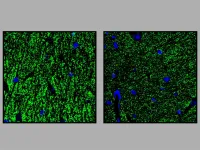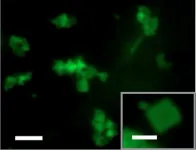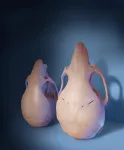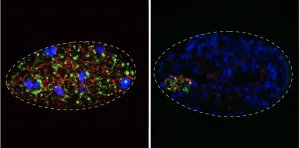(Press-News.org) As the planet continues to warm, the twin challenges of diminishing water supply and growing energy demand will intensify. But water and energy are inextricably linked. For instance, nearly a fifth of California's energy goes toward water-related activities, while more than a tenth of the state's electricity comes from hydropower. As society tries to adapt to one challenge, it needs to ensure it doesn't worsen the other.
To this end, researchers from UC Santa Barbara, Lawrence Berkeley National Laboratory and UC Berkeley have developed a framework to evaluate how different climate adaptations may impact this water-energy nexus. Their research appears in the open access journal Environmental Research Letters.
"Electricity and water systems are linked in many different ways," said coauthor Ranjit Deshmukh, an assistant professor in the environmental studies department. "Climate change is expected to stress these links so we presented a framework that maps these interdependencies and will enable us to understand and quantify its impacts on the energy-water nexus."
Although it's not the first study to look at these topics, it takes a more nuanced approach than the papers that have come before. "There have been many analyses on how climate change could affect the water and energy sectors separately, but those studies were not typically looking at interactions and feedbacks between the two," said lead author Julia Szinai of Berkeley Lab's Climate and Ecosystem Sciences Division. "Our paper develops a generalized framework that identifies how climate change affects these coupled water and electricity systems and potential adaptations to future gaps in supply and demand. By doing so we illustrate often overlooked tradeoffs and synergies in adapting to climate change."
The framework uses systems analysis to identify the biggest potential climate stressors on the water and energy sectors. It quantifies actions that will be needed to adapt to climate change, and examines the feedbacks that would result from these actions.
"For example, our framework shows how increased temperatures due to climate change will likely increase electricity demand for air conditioning and water demand for irrigation," Deshmukh explained. "Whereas snowpack loss in the Sierras and variable precipitation will affect the water supply, not just for urban and agricultural use, but also for hydropower generation and thermal power plant cooling."
California relies on snowpack in the Sierra Nevadas to slowly mete out water over the course of the year.
The team applied the framework they developed to California, which relies on the snowpack for a good deal of its water and expends significant amounts of energy to transport water from the north to the southern part of the state. They examined multiple adaptation strategies in the water sector and found that some are energy intensive while others can actually save both water and energy.
The researchers integrated data across a number of fragmented studies to estimate the overall range of possible water and energy futures for the state under various climate scenarios at the end of the century. Their analysis found that two factors will likely dominate climate change's direct impacts on California's electricity sector: higher air conditioning loads and decreased hydropower availability.
"One of the most important points of the paper is that adapting our water system to climate change can either significantly exacerbate electricity grid stress, or on the flip side, it could help to alleviate it," said co-author and Berkeley Lab climate scientist Andrew Jones. "If we focus on adapting the water system by using big transfers of water across basins, or by using energy-intensive desalination, that's just going to make the electricity problem much more difficult. If, on the other hand, we adapt the water system by conserving water, it's actually a win-win situation because you're also reducing the energy required for water."
Currently, a staggering 19% of California's electricity consumption goes toward water-related applications, such as treating, transporting, pumping and heating. Additionally, about 15% of in-state electricity generation comes from hydropower.
The state has already seen some impacts of climate change on its water-energy systems. Extended droughts exacerbated by climate change have led to spikes in electricity consumption for groundwater pumping, and corresponding hydropower deficits have required replacement by dirtier fossil fuels.
The team is certain that the climate crisis will have a huge impact on the state's future water supplies. That said, the effect is wildly uncertain. In the worst case, available water supplies could decrease 25%; however, they could increase 46%.
"There are significant uncertainties in the climate model projections for precipitation," said Deshmukh. "But irrespective of those uncertainties, the adaptation measures offer significant co-benefits." Conserving water would save energy as well as money for consumers, and allow for greater flow in the state's natural streams and rivers.
When the team applied their framework to the worst-case scenario, they found that choosing the most energy-intensive adaptation strategies in the water sector could result in an energy imbalance as large as that caused directly by climate change.
"I think this is the first study to show that water sector adaptation can have as large of an impact on the electricity sector as the direct effect of climate change itself," said Jones.
"This study has highlighted the benefit of coordinated adaptation planning between the two sectors," added lead author Szinai, "so we're now linking a more detailed water resources management model and an electricity planning model that can demonstrate resilient pathways for building out electricity infrastructure in the Western U.S. when climate change impacts are included from the water sector."
Deshmukh is currently leading a team to explore the connections between energy, water and the climate by quantifying the impacts of climate change on hydropower dams and thermal power plants in 12 countries across southern Africa. He hopes to identify optimal investments in electricity infrastructure.
"California has a choice in how it wants to adapt its water sector to the impacts of climate change," Deshmukh stated. "The state can either pursue energy intensive climate adaptation measures such as desalination or develop a portfolio of measures that maximize water conservation potential. Planners and policymakers in the water and energy sectors need to coordinate their actions and plans for adapting to climate change."
INFORMATION:
The study was supported by the Department of Energy Office of Science and the National Science Foundation. It is part of DOE's HyperFACETS project.
Impaired intelligence, movement disorders and developmental delays are typical for a group of rare diseases that belong to GPI anchor deficiencies. Researchers from the University of Bonn and the Max Planck Institute for Molecular Genetics used genetic engineering methods to create a mouse that mimics these patients very well. Studies in this animal model suggest that in GPI anchor deficiencies, a gene mutation impairs the transmission of stimuli at the synapses in the brain. This may explain the impairments associated with the disease. The results are now published ...
INDIANAPOLIS-- Researchers at the Indiana University Melvin and Bren Simon Comprehensive Cancer Center published promising findings today in the New England Journal of Medicine on preventing a common complication to lifesaving blood stem cell transplantation in leukemia.
Sherif Farag, MD, PhD, found that using a drug approved for Type 2 diabetes reduces the risk of acute graft-versus-host disease (GVHD), one of the most serious complications of blood stem cell transplantation. GVHD occurs in more than 30 percent of patients and can lead to severe side effects and potentially fatal results. Farag is ...
Chemists have developed a nanomaterial that they can trigger to shape shift -- from flat sheets to tubes and back to sheets again -- in a controllable fashion. The Journal of the American Chemical Society published a description of the nanomaterial, which was developed at Emory University and holds potential for a range of biomedical applications, from controlled-release drug delivery to tissue engineering.
The nanomaterial, which in sheet form is 10,000 times thinner than the width of a human hair, is made of synthetic collagen. Naturally occurring collagen is the most abundant protein in humans, making the new material intrinsically biocompatible.
"No one has previously made collagen ...
Alexandria, Va., USA -- The COVID-19 pandemic has significantly impacted dental education and training. The study "COVID-19 and Dental and Dental Hygiene Students' Career Plans," published in the JDR Clinical & Translational Research (JDR CTR), examined the short-term impact of the COVID-19 pandemic on dental hygiene and dental students' career intentions.
An anonymous online survey was emailed to dental and dental hygiene students enrolled at Virginia Commonwealth University School of Dentistry, Richmond, USA. The survey consisted of 81 questions that covered a wide range of topics including demographics, anticipated educational debt, career plans post-graduation, ...
CHAMPAIGN, Ill. -- In almost all successful advertising campaigns, an appeal to emotion sparks a call-to-action that motivates viewers to become consumers. But according to research from a University of Illinois Urbana-Champaign expert who studies consumer information-processing and memory, emotionally arousing advertisements may not always help improve consumers' immediate memory.
A new paper co-written by Hayden Noel, a clinical associate professor of business administration at the Gies College of Business at Illinois, finds that an ad's emotional arousal can have a negative effect on immediate ...
Using stem cells to regenerate parts of the skull, scientists corrected skull shape and reversed learning and memory deficits in young mice with craniosynostosis, a condition estimated to affect 1 in every 2,500 infants born in the United States, according to the Centers for Disease Control and Prevention. The only current therapy is complex surgery within the first year of life, but skull defects often return afterward. The study, supported by the National Institute of Dental and Craniofacial Research (NIDCR), could pave the way for more effective and less invasive therapies for children with craniosynostosis. ...
Humans feeding leftover lean meat to wolves during harsh winters may have had a role in the early domestication of dogs, towards the end of the last ice age (14,000 to 29,000 years ago), according to a study published in Scientific Reports.
Maria Lahtinen and colleagues used simple energy content calculations to estimate how much energy would have been left over by humans from the meat of species they may have hunted 14,000 to 29,000 years that were also typical wolf prey species, such as horses, moose and deer. The authors hypothesized that if wolves and humans had hunted the same animals during harsh winters, humans would have killed wolves to reduce competition rather than domesticate them. With the exception of Mustelids such as weasels, ...
"Nature red in tooth and claw" - The battle to survive is fought down to the level of our genes. Toxin-antidote elements are gene pairs that spread in populations by killing non-carriers. Now, research by the Burga lab at IMBA and the Kruglyak lab at the University of California, Los Angeles shows that these elements are more common in nature than first thought and have evolved a wide range of mechanisms to force their inheritance and propagate in populations - a parasite within the genome.
Originally described in the model nematode Caenorhabditis elegans, toxin-antidote elements consist of two linked genes, a toxin and its antidote. While the toxin is loaded into eggs by mothers, only embryos that inherit the element express the antidote. Thus, the ...
The National Human Genome Research Institute (NHGRI) within the National Institutes of Health (NIH) has released a new action agenda for a diverse genomics workforce. This ambitious set of goals, objectives, and implementation strategies details NHGRI's plans for enhancing the diversity of the genomics workforce by 2030.
"To reach its full potential, the field of genomics requires a workforce that better reflects the diversity of the U.S. population," NHGRI Director Eric Green, M.D., Ph.D., said. "Fostering an appropriately diverse genomics workforce of the future requires an immediate and substantial commitment ...
Noncognitive skills and cognitive abilities are both important contributors to educational attainment -- the number of years of formal schooling that a person completes -- and lead to success across the life course, according to a new study from an international team led by researchers at Columbia University Mailman School of Public Health, the University of Texas at Austin, and Vrije Universiteit Amsterdam. The research provides evidence for the idea that inheriting genes that affect things other than cognitive ability are important for understanding differences in people's life outcomes. Until now there had been questions about what these noncognitive skills are and how much they really matter for life outcomes. The new findings are published ...





